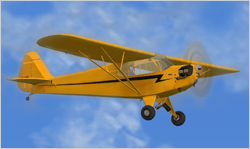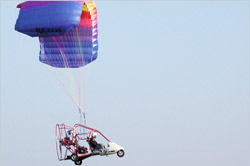Light Sport Aircraft (LSA) are defined by a set of governing regulations. Among the resulting LSA models, there are three styles that are prevalent: (1) Fixed wing, conventional style (airplanes), (2) Powered Parachutes, and (3) “Trikes” (a.k.a. weight-shift control, as the FAA calls them).
The conventional airplane style is the one that everyone recognizes. It has a narrow body with a propeller on the front, two wings and a tail. Examples range from the veteran standby Piper J-3 Cub to the modern advanced Icon A5.

The other two popular categories have been operating as “ultralights” for over 30 years. First of those two is the Powered Parachute (PPC), the simplest aircraft in the world to operate and it flies at one speed—about 30 knots. You can think of it as “the dune buggy of the skies.”
As pictured here, the Powered Parachute is a cage structure pushed by a propeller on the back and carried by a square parachute above.

The second is the Weight-Shift Control (WSC), commonly known as the Trike. It is much like a hang glider, but includes an undercarriage and engine so it can take off and climb same as regular airplanes. It can fly at many speeds ranging from 20 to 100 MPH depending on the make and model. The Trike can be considered “the motorcycle of the sky.”

Easy to learn
Each of these three LSA styles are easy to learn, but vary in their ease of operation. The Powered Parachute is the easiest with only one axis of control—that is, roll. The Weight-Shift Control (“Trike”) comes second easiest with two axes of control: roll and pitch. The standard, conventional airplane style has three-axis control (roll, pitch and yaw) making it the most difficult of the three. The less axes of control, the easier it is to fly.
What do you think of these different LSA styles of aircraft? Put your comments and questions into the Comments section below.
About Paul
Paul Hamilton is recognized as an expert in the Light Sport Aircraft (LSA) category. He is a pilot, flight instructor, aviation engineer, consultant, writer, video producer and business owner. Through his company, Adventure Productions, Paul specializes in teaching and informing people about flying (especially LSA) including students, pilots, instructors, mechanics, engineers and aerodynamicists.




